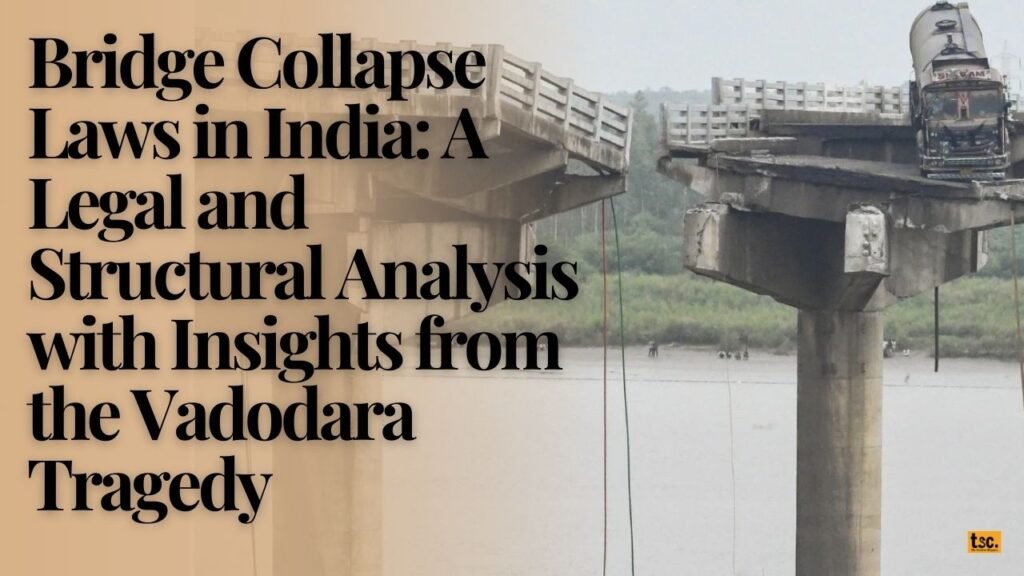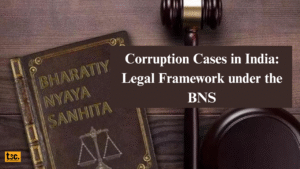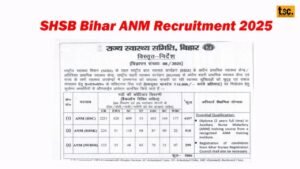Bridge Collapse Laws in India: A Legal and Structural Analysis with Insights from the Vadodara Tragedy
Adv Shreya, LLM 12 July 2025 0
Bridge Collapse Laws in India: A Legal and Structural Analysis with Insights from the Vadodara Tragedy
Bridge Collapse Laws in India: A Legal and Structural Analysis with Insights from the Vadodara Tragedy. Bridge collapses in India are a grim reminder of aging infrastructure, official negligence, and the urgent need for legal reforms. The tragic Vadodara bridge collapse on July 9, 2025, has once again sparked national outrage and raised important legal, civil, and structural questions. This article provides an in-depth look at the laws applicable to bridge collapses in India, examines the Vadodara Gambhira bridge tragedy, and highlights the gaps in our current legal and policy framework.
What Laws Govern Bridge Collapse in India?
India does not have a standalone law dedicated to bridge safety or structural integrity. However, various provisions under criminal law, civil law, constitutional law, and administrative regulations apply in the aftermath of such disasters.
1. Criminal Laws: Bharatiya Nyaya Sanhita, 2023
Under the BNS, the following sections are commonly invoked when a bridge collapse occurs due to negligence or omission:
Section 106: Causing death by negligence
This provision replaces IPC Section 304A. It criminalizes any rash or negligent act not amounting to culpable homicide that causes death. Penalty: imprisonment up to 5 years, or fine, or both.
Section 105(2): Culpable homicide not amounting to murder
This corresponds to the former IPC Section 304. If the collapse was foreseeable and authorities ignored safety warnings or engaged in willful neglect, charges under this section may apply. Penalty: imprisonment ranging from 10 years to life, depending on circumstances.
Section 120: Voluntarily causing hurt by dangerous means
Covers injuries caused due to reckless or negligent maintenance that endangers life or safety.
Section 121: Causing grievous hurt by rash or negligent act
Similar to IPC Section 338. Applicable if structural failure due to negligence results in serious injuries.
Section 196: Abetment and common intention
If multiple officials or entities conspired or acted jointly in negligence or omission, they may be charged under this section.
Criminal liability is generally placed on engineers, contractors, or officials responsible for the maintenance or construction of the bridge.
2. Civil Liability: Tort Law in India
Victims and their families can file civil suits for compensation under tort law based on negligence. Though India lacks a codified tort liability act, courts recognize compensation claims where there’s a breach of the duty of care by public authorities or private contractors.
The concept of vicarious liability holds the government accountable for the failures of its employees or third-party agencies.
3. Constitutional Liability
Article 21 of the Constitution of India guarantees the Right to Life and Safety. Courts have expanded this to include the right to safe public infrastructure. In cases where negligence leads to loss of life, the state may be held accountable for violating fundamental rights.
Vadodara Gambhira Bridge Collapse: A Legal Case Study
On July 9, 2025, the Gambhira bridge in Vadodara, Gujarat collapsed, killing at least six people and injuring several others. This bridge was over 50 years old and had shown visible signs of deterioration.
Key Findings:
-
Ignored Warnings: Multiple safety warnings were issued between 2021 and 2023. The bridge had been declared “unfit for public use” by engineers.
-
Structural Failure: The collapse was attributed to crushing of pedestals and articulation joints, which compromised the entire support system.
-
Administrative Negligence: Despite multiple alerts, no timely action was taken by the Roads and Buildings Department.
-
Legal Action Taken: An FIR was registered under Section 194 of the Bharatiya Nagarik Suraksha Sanhita, replacing older IPC provisions. Four engineers were suspended.
Compensation Announced:
-
₹4 lakh ex gratia by the Gujarat government for each deceased.
-
₹2 lakh from the Prime Minister’s National Relief Fund.
-
₹50,000 for the injured victims.
Legal and Policy Gaps Exposed
The Vadodara bridge collapse is not the first of its kind. Incidents like the Morbi bridge collapse (2022) have highlighted the same pattern of:
-
Inadequate infrastructure audits.
-
Ignored inspection reports.
-
Absence of regular structural assessments.
-
Lack of codified tort or public liability legislation.
Despite repeated disasters, India still does not have a dedicated Bridge Safety Act or an institutional mechanism for regular maintenance and enforcement.
Key Recommendations
To prevent future tragedies and strengthen the legal framework, the following steps are essential:
-
Enact a Bridge Safety and Maintenance Law: Mandatory periodic inspections and certifications should be codified.
-
Create a National Public Infrastructure Audit Authority: Independent of political interference, this body should publish public audit reports.
-
Introduce Codified Public Liability Law: Victims should have swift legal remedies under a structured compensation system.
-
Increase Criminal Accountability: Strict penalties for officials and contractors found negligent.
-
Transparent Tendering and Maintenance Contracts: All infrastructure projects must undergo rigorous scrutiny at every stage.
Conclusion
Bridge Collapse Laws in India: A Legal and Structural Analysis with Insights from the Vadodara Tragedy. The Vadodara bridge collapse is a tragic example of how systemic failures, both legal and administrative, can cost innocent lives. While the legal system provides post-incident remedies, there is a dire need to shift focus to prevention, accountability, and reform.
India must move beyond reactive justice and adopt a forward-looking legal and policy approach to protect its citizens from further infrastructural disasters. A combination of strict enforcement, legal reform, and structural audit mechanisms is the need of the hour.
Stay tuned on our website, as if any official information pops up then we will update you in minutes! If you want all the latest updates on time, then join our student community on WhatsApp!
Choose the right career yourself by booking personal guidance from professionals on Mytagapp.com









